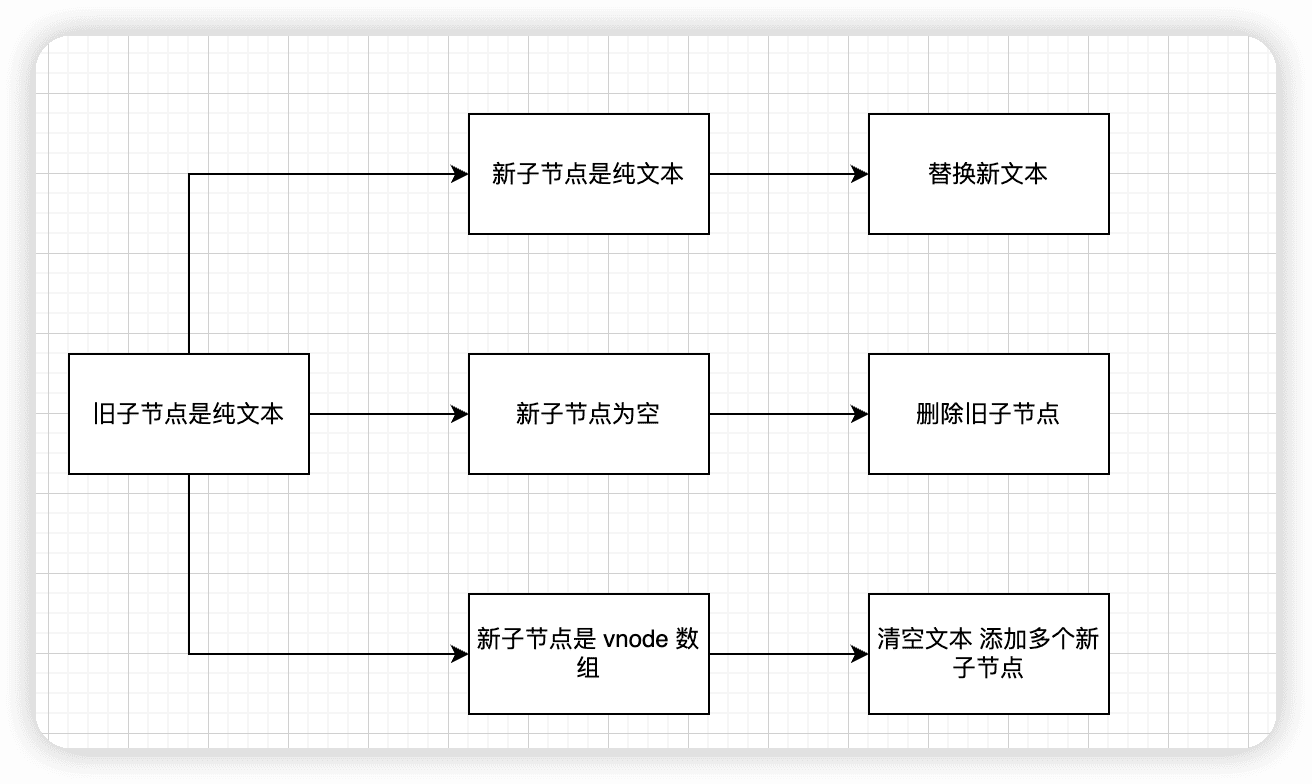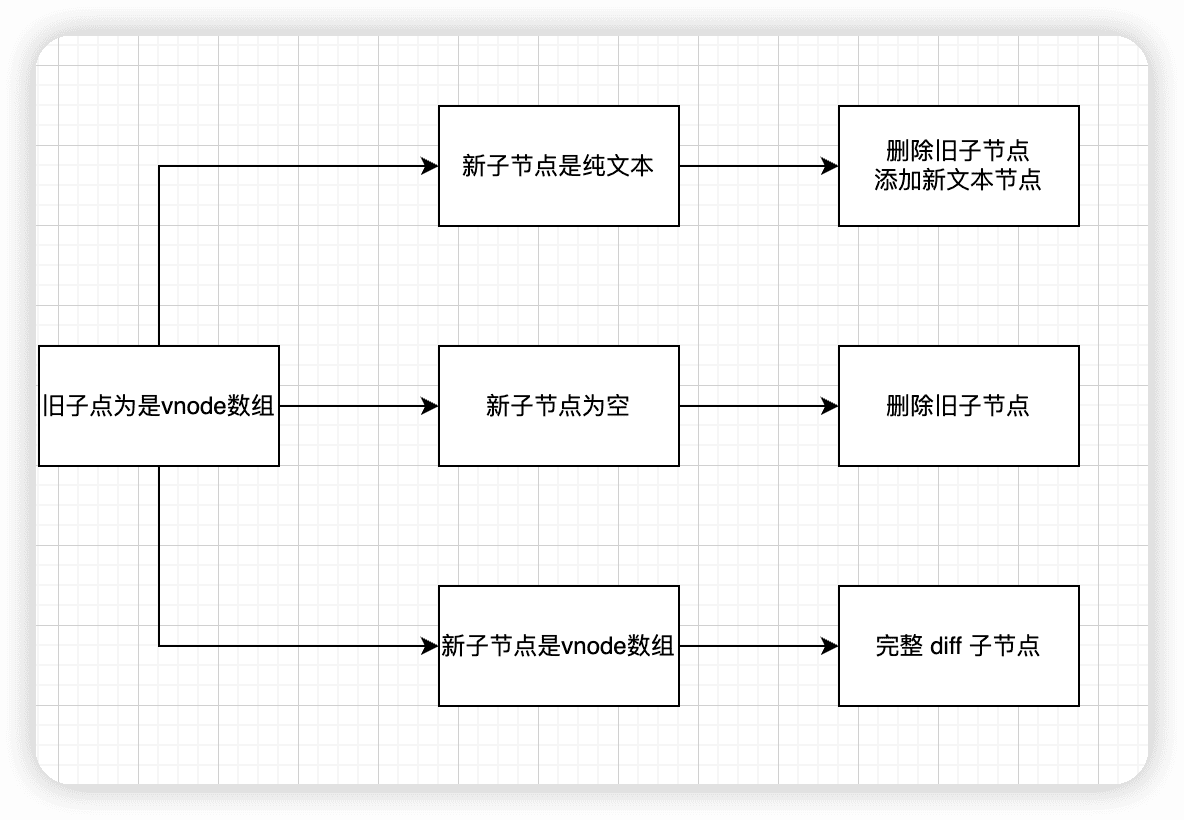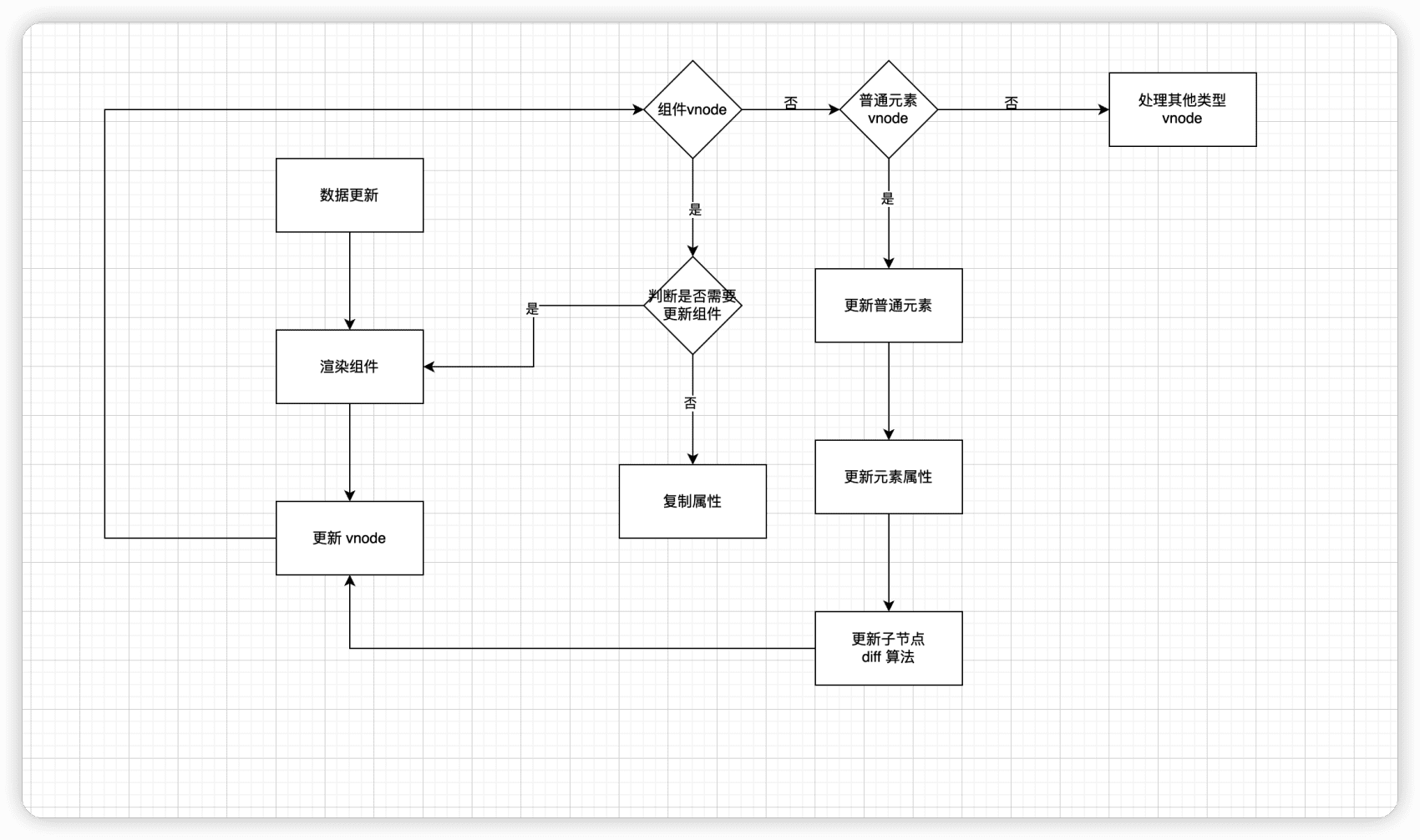Appearance
组件的渲染流程
渲染函数更新组件的过程
更新组件主要做了三件事情
- 更新组件 vnode 节点
- 渲染新的子树 vnode
- 根据新旧子树 vnode 执行 patch 逻辑
patch 流程
首先判断 新旧节点是否相同 vnode 类型 如果不同 则删除旧的节点 再创建新的节点 如果类型相同 则需要进入 diff 更新流程了 然后根据不同的 vnode 类型 执行 不同的逻辑处理
ts
const patch: PatchFn = (
n1,
n2,
container,
anchor = null,
parentComponent = null,
parentSuspense = null,
isSVG = false,
slotScopeIds = null,
optimized = __DEV__ && isHmrUpdating ? false : !!n2.dynamicChildren
) => {
if (n1 === n2) {
return
}
// patching & not same type, unmount old tree
if (n1 && !isSameVNodeType(n1, n2)) {
anchor = getNextHostNode(n1)
unmount(n1, parentComponent, parentSuspense, true)
n1 = null
}
if (n2.patchFlag === PatchFlags.BAIL) {
optimized = false
n2.dynamicChildren = null
}
const { type, ref, shapeFlag } = n2
switch (type) {
case Text:
processText(n1, n2, container, anchor)
break
case Comment:
processCommentNode(n1, n2, container, anchor)
break
case Static:
if (n1 == null) {
mountStaticNode(n2, container, anchor, isSVG)
} else if (__DEV__) {
patchStaticNode(n1, n2, container, isSVG)
}
break
case Fragment:
processFragment(
n1,
n2,
container,
anchor,
parentComponent,
parentSuspense,
isSVG,
slotScopeIds,
optimized
)
break
default:
if (shapeFlag & ShapeFlags.ELEMENT) {
processElement(
n1,
n2,
container,
anchor,
parentComponent,
parentSuspense,
isSVG,
slotScopeIds,
optimized
)
} else if (shapeFlag & ShapeFlags.COMPONENT) {
processComponent(
n1,
n2,
container,
anchor,
parentComponent,
parentSuspense,
isSVG,
slotScopeIds,
optimized
)
} else if (shapeFlag & ShapeFlags.TELEPORT) {
;(type as typeof TeleportImpl).process(
n1 as TeleportVNode,
n2 as TeleportVNode,
container,
anchor,
parentComponent,
parentSuspense,
isSVG,
slotScopeIds,
optimized,
internals
)
} else if (__FEATURE_SUSPENSE__ && shapeFlag & ShapeFlags.SUSPENSE) {
;(type as typeof SuspenseImpl).process(
n1,
n2,
container,
anchor,
parentComponent,
parentSuspense,
isSVG,
slotScopeIds,
optimized,
internals
)
} else if (__DEV__) {
warn('Invalid VNode type:', type, `(${typeof type})`)
}
}
// set ref
if (ref != null && parentComponent) {
setRef(ref, n1 && n1.ref, parentSuspense, n2 || n1, !n2)
}
}首先处理组件
- 执行 processComponent 中 再执行 updateComponent 函数来更新子组件
- updateComponent 函数在更新子组件的时候 会先执行 shouldUpdateComponent 函数 根据新旧子组件 vnode 判断是否需要更新
- shouldUpdateComponent 内部 主要通过检测并对比组件的 vnode 中的 props children dirs 和 transition 等属性 来决定是否更新
- shouldUpdateComponent 返回 true 会先执行 invalidateJob(instance.update)
- 再执行 子组件的副作用函数 instance.update 主动触发子组件的更新
ts
const processComponent = (
n1: VNode | null,
n2: VNode,
container: RendererElement,
anchor: RendererNode | null,
parentComponent: ComponentInternalInstance | null,
parentSuspense: SuspenseBoundary | null,
isSVG: boolean,
slotScopeIds: string[] | null,
optimized: boolean
) => {
n2.slotScopeIds = slotScopeIds
if (n1 == null) {
if (n2.shapeFlag & ShapeFlags.COMPONENT_KEPT_ALIVE) {
;(parentComponent!.ctx as KeepAliveContext).activate(
n2,
container,
anchor,
isSVG,
optimized
)
} else {
mountComponent(
n2,
container,
anchor,
parentComponent,
parentSuspense,
isSVG,
optimized
)
}
} else {
updateComponent(n1, n2, optimized)
}
}ts
const updateComponent = (n1: VNode, n2: VNode, optimized: boolean) => {
const instance = (n2.component = n1.component)!
if (shouldUpdateComponent(n1, n2, optimized)) {
if (
__FEATURE_SUSPENSE__ &&
instance.asyncDep &&
!instance.asyncResolved
) {
// async & still pending - just update props and slots
// since the component's reactive effect for render isn't set-up yet
if (__DEV__) {
pushWarningContext(n2)
}
updateComponentPreRender(instance, n2, optimized)
if (__DEV__) {
popWarningContext()
}
return
} else {
// normal update
instance.next = n2
// in case the child component is also queued, remove it to avoid
// double updating the same child component in the same flush.
invalidateJob(instance.update)
// instance.update is the reactive effect.
instance.update()
}
} else {
// no update needed. just copy over properties
n2.el = n1.el
instance.vnode = n2
}
}处理普通元素
- 执行 processElement 逻辑
- 更新元素的过程中主要做了两件事 更新 props 以及 更新子节点
ts
const processElement = (
n1: VNode | null,
n2: VNode,
container: RendererElement,
anchor: RendererNode | null,
parentComponent: ComponentInternalInstance | null,
parentSuspense: SuspenseBoundary | null,
isSVG: boolean,
slotScopeIds: string[] | null,
optimized: boolean
) => {
isSVG = isSVG || (n2.type as string) === 'svg'
if (n1 == null) {
mountElement(
n2,
container,
anchor,
parentComponent,
parentSuspense,
isSVG,
slotScopeIds,
optimized
)
} else {
patchElement(
n1,
n2,
parentComponent,
parentSuspense,
isSVG,
slotScopeIds,
optimized
)
}
}更新 props
patchProps 函数 会更新 DOM 节点的 class style event 等等其他 dom 属性
ts
const patchProps = (
el: RendererElement,
vnode: VNode,
oldProps: Data,
newProps: Data,
parentComponent: ComponentInternalInstance | null,
parentSuspense: SuspenseBoundary | null,
isSVG: boolean
) => {
if (oldProps !== newProps) {
if (oldProps !== EMPTY_OBJ) {
for (const key in oldProps) {
if (!isReservedProp(key) && !(key in newProps)) {
hostPatchProp(
el,
key,
oldProps[key],
null,
isSVG,
vnode.children as VNode[],
parentComponent,
parentSuspense,
unmountChildren
)
}
}
}
for (const key in newProps) {
// empty string is not valid prop
if (isReservedProp(key)) continue
const next = newProps[key]
const prev = oldProps[key]
// defer patching value
if (next !== prev && key !== 'value') {
hostPatchProp(
el,
key,
prev,
next,
isSVG,
vnode.children as VNode[],
parentComponent,
parentSuspense,
unmountChildren
)
}
}
if ('value' in newProps) {
hostPatchProp(el, 'value', oldProps.value, newProps.value)
}
}
}更新子节点
patchChildren 函数
ts
const patchChildren: PatchChildrenFn = (
n1,
n2,
container,
anchor,
parentComponent,
parentSuspense,
isSVG,
slotScopeIds,
optimized = false
) => {
const c1 = n1 && n1.children
const prevShapeFlag = n1 ? n1.shapeFlag : 0
const c2 = n2.children
const { patchFlag, shapeFlag } = n2
// fast path
if (patchFlag > 0) {
if (patchFlag & PatchFlags.KEYED_FRAGMENT) {
// this could be either fully-keyed or mixed (some keyed some not)
// presence of patchFlag means children are guaranteed to be arrays
patchKeyedChildren(
c1 as VNode[],
c2 as VNodeArrayChildren,
container,
anchor,
parentComponent,
parentSuspense,
isSVG,
slotScopeIds,
optimized
)
return
} else if (patchFlag & PatchFlags.UNKEYED_FRAGMENT) {
// unkeyed
patchUnkeyedChildren(
c1 as VNode[],
c2 as VNodeArrayChildren,
container,
anchor,
parentComponent,
parentSuspense,
isSVG,
slotScopeIds,
optimized
)
return
}
}
// children has 3 possibilities: text, array or no children.
if (shapeFlag & ShapeFlags.TEXT_CHILDREN) {
// text children fast path
if (prevShapeFlag & ShapeFlags.ARRAY_CHILDREN) {
unmountChildren(c1 as VNode[], parentComponent, parentSuspense)
}
if (c2 !== c1) {
hostSetElementText(container, c2 as string)
}
} else {
if (prevShapeFlag & ShapeFlags.ARRAY_CHILDREN) {
// prev children was array
if (shapeFlag & ShapeFlags.ARRAY_CHILDREN) {
// two arrays, cannot assume anything, do full diff
patchKeyedChildren(
c1 as VNode[],
c2 as VNodeArrayChildren,
container,
anchor,
parentComponent,
parentSuspense,
isSVG,
slotScopeIds,
optimized
)
} else {
// no new children, just unmount old
unmountChildren(c1 as VNode[], parentComponent, parentSuspense, true)
}
} else {
// prev children was text OR null
// new children is array OR null
if (prevShapeFlag & ShapeFlags.TEXT_CHILDREN) {
hostSetElementText(container, '')
}
// mount new if array
if (shapeFlag & ShapeFlags.ARRAY_CHILDREN) {
mountChildren(
c2 as VNodeArrayChildren,
container,
anchor,
parentComponent,
parentSuspense,
isSVG,
slotScopeIds,
optimized
)
}
}
}
}元素子节点 vnode 一般会有 三种情况 : 纯文本 vnode 数组 和空 纯文本 
vnode数组 
空 
diff 算法
同步头部节点
需要维护几个变量
- 头部的索引 i
- 旧子节点的尾部索引 e1
- 新子节点的尾部索引 e2 从头部开始 依次对比新旧节点 如果相同 执行 patch 更新节点 不同或者 索引 i 大于 e1 或 e2 则同步过程结束
同步尾部节点
依次对比新旧节点 如果相同 执行 patch 更新节点 不同 或者 索引 i 大于 e1 或e2 则同步过程结束
处理完 头部尾部节点 只会剩下三种情况
- 新子节点有剩余 添加新节点 a. 如果索引 i 大于 尾部索引 e1 并且小于 e2 b. 直接挂载新子树丛索引 i 开始 到 索引 e2 部分
- 旧子节点有剩余 删除多余节点 a. 如果索引 i 大于 尾部索引 e2 b. 直接删除旧子树从索引 i 开始到索引 e1 部分到节点
- 未知子序列 a. diff
总结
- vue 视图更新粒度是组件级别的
- patch 过程 递归便利子节点的时候 如果遇到组件的 vnode 会进行一些判断 在满足某些条件的时候会触发子组件的更新
- 对于普通元素的节点 主要是更新一些属性及其子节点
- 子节点的更新又分为多种情况 其中 最复杂的情况为数组到数组的更新 要在内部根据不同的情况分成几个 diff 流程 a. 在需要移动的时候还要求解子节点的最长递增子序列
- 整个更新过程 利用来 树的深度遍历 通过递归执行 patch 函数 完成整个组件树的更新
